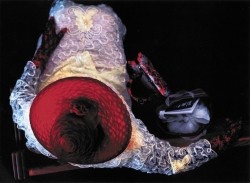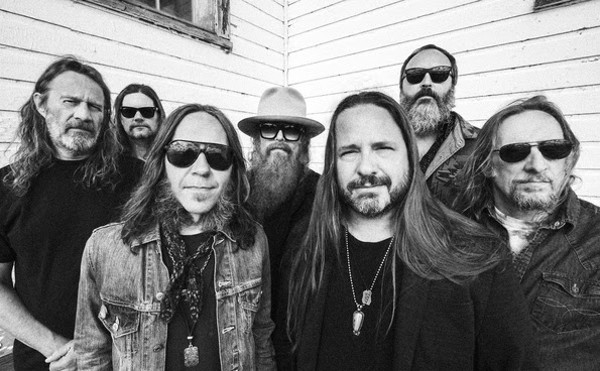Photographer Michael Levy - white, middle-class and Jewish - took on the project of documenting the social, emotional and spiritual life of Cleveland's African-American churches following a chance assignment from The Plain Dealer, where he was formerly a staff photographer. It was a project fraught with the danger that it would present the fawning stereotypes outsiders often project onto the black worship experience. Yet the collection of images on display at Convivium33 in Revelations: The Black Church Project, a show culled from Levy's new book Revelations: Photographs of Cleveland's African American Churches, is infused with an easy warmth, depth and empathy that resonates long after the photos' immediate visual impact dissipates.
That's not to underestimate the visual impact. These are powerful, well-composed images.
Levy uses a couple of techniques that could theoretically be showy or distracting - including mixing some color in with his mostly black-and-white shots, and presenting most of the photos as diptychs, two images blended together in many cases so seamlessly, you'll instinctively read them as one. It seems on the surface a little gimmicky, a way to jazz up straight photojournalism, since any of the photos could stand on their own. But the more you look, the more the sets of images offer a perfect balance to each other, less contrast than reinforcement and amplification of a theme or the presentation of different sides of it.
The duo of black-and-white photos titled "The Baptism of the Glenville High School Football Team" combines a shot of one young man, isolated, his arms crossed, with a group shot of a cluster of men swathed in white towels fresh from their dunking. The composition depicts baptism both as a deeply personal experience and a shared community experience. Ê"Intersection" balances a vertical color shot of the bright red double-door of a church, each half adorned with a large cross, with a horizontal black-and-white shot of a row after row of pews, the back of each glazed with light, with one center pew gripped by a pair of hands belonging to an unseen, kneeling worshipper. It's notable for its sheer compositional beauty, a visual music so intense that it overwhelms the slightly jarring combination of color and black-and-white photos.
There's similar visual music in "Two Crosses." At left, a preacher lays his hand on the shoulder of a kneeling worshipper, with the cross in the church's window looming in darkness high above them. The photo at the right is dominated by a large cross studded with what looks like dressing-table light bulbs, set in a rectangular window. It tilts toward the left behind the large outlined head of a child in the foreground. The shapes, lines and black, white and gray tones echo and interact between the two images to create a multi-layered experience. The two brilliantly colored photos that make up "Tent Revival" show a pastor in the lower left-hand corner in partial silhouette, against a backdrop of a yellow-and-gray striped tent whose diagonals thrust dramatically toward the upper right-hand corner of the frame. In the first, he reaches out, his face rimmed with light, his hand flowing along the diagonal lines of the tent stripes. In the second, he's seen from the back, his shoulder and shiny bald head turned toward the invisible congregation. The two photos reflect the build-up and release found in any effective sermon. It's one of the show's flashier images.
But Levy mostly doesn't go for obvious roof-raising moments, choosing instead more reflective yet revealing ones. In "The Music Director," a man sits at a keyboard in a Plexiglass booth, his head turned toward the viewer, while behind him in the distance, a white-robed choir performs on a vast stage, their image amplified on a screen behind him. Despite the vast size of the church and the large choir, he's in his own world, his face a mask of solemn absorption. In "H. Turner Thompson," a keyboard is reflected in the glasses of the subject's slightly bowed head, seen in tight close-up. A hum of music underpins all the photos, whether it's implied by the content of the images or by the compositions with their skillful patterns of repetition and counterpoint.
Levy enhances the reflective mood of his images with copious and artful use of silhouette and near silhouette, suggesting attitudes and emotions rather than spelling them out. "A Man in Black, A Woman in White" is all suggestion: On the left side, a man in a dark suit is captured from behind, his hand upraised and fingers spread, light striking his hand and the top of his head, balanced on the white strip of his collar. In the right-hand image, an imposing woman in a white, intricately appliquéd coat in hand, anchors a pew in the foreground, while other figures scattered around the other pews are barely discernable in the church's dim interior. She's watchful, her face, in semi-darkness, composed.
Although you could buy the book (an oversized volume with outstanding reproductions, a bargain at $39), it's worth seeing at the gallery, not simply for the impact of the large prints with all their subtle tonalities, but also because the show is perfectly suited to the atmosphere of the gallery, a decommissioned church. At the opening, with lit candles flickering throughout the spacious, high-ceilinged former sanctuary, it felt as if the Spirit was indeed moving through the room.












